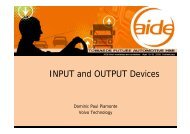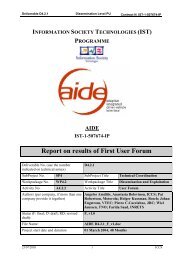download deliverable - AIDE
download deliverable - AIDE
download deliverable - AIDE
Create successful ePaper yourself
Turn your PDF publications into a flip-book with our unique Google optimized e-Paper software.
<strong>AIDE</strong> D4.1.6 Final Activity Report PU Contract N. IST-1-507674-IP<br />
2 Background<br />
The following is a quote from the Description of Work (Annex I to the project contract):<br />
Every year, about 45 000 people die and 1.5 millions people are injured in traffic accidents in<br />
Europe. These figures imply that one person out of every 200 European citizens is injured in a<br />
traffic accident each year and that around one out 80 European citizens die 40 years short of their<br />
expected lifetime. It is known that the great majority of road accidents (about 90-95%) are caused<br />
by human error (Treat, et al., 1979). More recent data has identified inattention (including<br />
distraction, “looked but did not see” and falling asleep at the wheel) as the primary cause of<br />
accidents, accounting for at least 25% of the crashes (Wang et al., 1996). […]<br />
HMI design for maximising the safety benefits of new Advanced Driver Assistance Systems<br />
(ADAS)<br />
Today, a wide range of Advanced Driver Assistance Systems (ADAS) are being developed for<br />
enhancing the driver’s perception of the hazards, and/or partly automating the driving task. These<br />
include speed alert, lane support/blind spot detection, automated safe following, pedestrian<br />
detection, vision enhancement and driver impairment monitoring. These systems have great<br />
potential for reducing accidents, in particular the great portion related to human error (European<br />
Commission, 2002). The safety impact of these systems depends will to a great extent be<br />
determined by their interaction with the driver. For example, in order to efficiently support the<br />
driver in avoiding crashing into a front obstacle, it is crucial that the warning/feedback given by the<br />
system intuitively generates the appropriate response (e.g. an avoidance manoeuvre). New<br />
technologies, exploiting new concepts for driver-vehicle interaction in multiple sensory modalities<br />
(e.g. visual, tactile and auditory), offer great potential for maximising the potential safety benefits of<br />
ADAS. […]<br />
Moreover, it is well known that the introduction of new safety functions may induce longer-term<br />
changes in driver behaviour. This type of behavioural change, often referred to as behavioural<br />
adaptation, may significantly affect the actual (as compared to the expected) safety benefits of a<br />
safety measure, both in positive and negative directions (OECD, 1990). Behavioural effects<br />
demonstrated for ADAS include system over-reliance on in-vehicle safety technologies resulting<br />
diversion of attention from the driving task and safety margin compensation (e.g. increasing speed<br />
in response to enhanced visibility in adverse conditions; e.g. Fosser, Saetermo and Sagberg, 1997;<br />
Nilsson, 1995 and Brown, 2000; see Smiley, 2000, for a review). […]<br />
Finally, the potential safety impact of an ADAS ultimately depends on its market penetration rate<br />
and whether it is actually used by drivers. Here, the human-machine interface is of crucial<br />
importance; annoying system behaviour (e.g. nuisance warnings) will lead to drivers simply<br />
abandoning the system, which hence obviously looses its potential safety benefit.<br />
HMI design for minimising workload and distraction imposed by In-vehicle Information<br />
Systems (IVIS)<br />
In addition to Advanced Driver Assistance Systems, a growing number of In-vehicle Information<br />
Systems (IVIS) are being introduced in modern vehicles. By contrast to ADAS, these systems<br />
provide services not directly relevant for the primary driving task and thus impose a secondary tasks<br />
on the driver. Moreover, the in-vehicle use of portable computing devices e.g. hand-held mobile<br />
phones and portable digital assistants (PDAs), often referred to as Nomad devices, is increasing<br />
rapidly.<br />
These systems have great potential for increasing mobility and comfort. For example fleet<br />
management systems enhance the efficiency of work in the freight industry and road-and traffic<br />
information systems potentially facilitate the quality of life for the commuter. However, information<br />
systems in vehicles may also compete with the primary driving task for the driver’s attention and<br />
08/10/2008 8 VTEC







